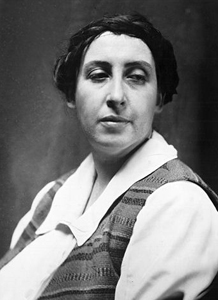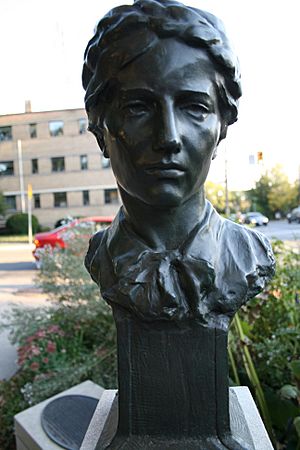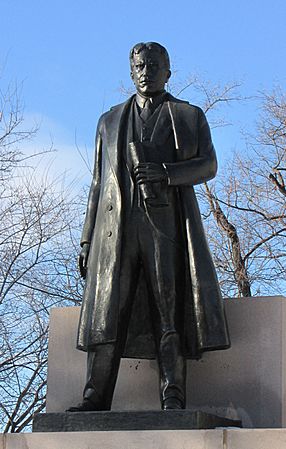Frances Loring facts for kids
Quick facts for kids
Frances Loring
|
|
|---|---|
 |
|
| Born | October 14, 1887 Wardner, Idaho, United States
|
| Died | February 5, 1968 (aged 80) Newmarket, Ontario, Canada
|
| Nationality | Canadian |
| Education | Art Institute of Chicago |
| Known for | sculptor |
|
Notable work
|
Queen Elizabeth Way Monument |
| Partner(s) | Florence Wyle |
Frances Norma Loring (born October 14, 1887, died February 5, 1968) was a famous Canadian sculptor. She created many important statues and artworks. She is well-known for her close friendship and professional work with fellow sculptor Florence Wyle.
Contents
Frances Loring's Artistic Journey
Frances Loring started her art studies in Europe. Later, she went to the Art Institute of Chicago in the United States. There, she learned from a well-known sculptor named Lorado Taft.
Loring was a member of important art groups in Canada. These included the Royal Canadian Academy of Arts and the Ontario Society of Artists. She also helped create the Federation of Canadian Artists in 1941. In the 1950s, she was involved in starting the Canada Council, which supports arts in Canada.
In 1960, Frances Loring represented Canada at the Venice Biennale. This is a very famous art exhibition held in Italy.
Famous Sculptures by Loring
Frances Loring created two very important sculptures in Canada. One is the Queen Elizabeth Way Monument, made in 1939. This monument is now in Toronto. The other is a statue of Robert Borden, who was a Canadian Prime Minister. This statue was finished in 1957 and stands on Parliament Hill in Ottawa.
Working with Florence Wyle
Frances Loring is often talked about with her close friend and fellow sculptor, Florence Wyle. They became two of the first well-known female sculptors in Canada. Their friendship and work together lasted for over 60 years. They first met at the Art Institute of Chicago in 1905.
Loring and Wyle worked together on many art projects. They greatly influenced Canadian art. They helped show that sculpture was just as important as painting or other art forms. In 1920, they moved into an old church building. This church became their home and art studio. As their sculptures became popular, the church also became the main office for the Sculptors' Society of Canada. Both Loring and Wyle were founding members of this society.
Early Life and Education
Frances Loring was born in Wardner, Idaho, in the United States. Her birthday was October 14, 1887. Her father, Frank Curtis Loring, was a mining engineer. Her mother was Charlotte Moore.
Loring studied art at many different schools. She attended the École des Beaux-Arts in Switzerland. She also studied at the Académie Colarossi in Paris, France. In the United States, she went to the Art Institute of Chicago. She also studied at the School of the Museum of Fine Arts at Tufts in Boston. Her studies continued at the Art Students League of New York.
Life in New York and Toronto
At the Art Institute of Chicago, Loring met Florence Wyle. They became lifelong friends and collaborators. In 1909, Loring moved to New York City. Soon after, Wyle joined her there. Their first shared studio home was on MacDougal Alley. This was a lively area for artists in Greenwich Village. They lived in a converted stable and created famous sculptures of each other.
In 1913, Loring and Wyle moved to Toronto, Canada. People in Toronto started calling them "The Girls." They quickly became very important artists in the city and across Canada. They received major art projects during World War I and World War II. In Toronto, they first rented a studio above a carpenter's shop.
Eight years later, in 1920, Frances (who was 33) and Florence (who was 39) bought "The Church." This building was at 110 Glenrose Avenue in the Moore Park neighborhood. Today, a small park called the Loring-Wyle Parkette is next to "The Church." It has sculpture busts of Loring and Wyle that they made of each other.
In 1928, Loring and Wyle helped start the Sculptors' Society of Canada. Other founding members included Alfred Laliberté, Elizabeth Wyn Wood, Emanuel Hahn, and Henri Hébert. "The Church" was not just their home and studio. It also became the official office for the Sculptors' Society of Canada. It was a popular meeting place for artists in Toronto. A. Y. Jackson, a famous Canadian painter, called it "the most fascinating gathering place in the country."
Loring's Artistic Creations
Frances Loring created hundreds of different artworks. She used many materials and styles. Her art included large public monuments, sculptures, and memorials. She made war memorials after World War I. She also created sculptures for buildings and portraits of people.
During World War I, she received commissions from the Canadian War Memorial Fund. The City of Toronto government also asked her to create sculptures. These sculptures showed women working on the Canadian home front during the war.
For the Queen Elizabeth Way Monument, Loring designed and carved the lion and the column. This monument was for Queen Elizabeth The Queen Mother and King George VI. Florence Wyle carved the smaller figures of the King and Queen. This monument is also known as the Lion Monument. Since 1975, it has been located in Casimir Gzowski Park in Toronto.
Loring also created a bronze portrait of Prime Minister Robert Borden. She made various war memorials in Cambridge, Ontario.
The Sculpture Fund
In 1965, Loring and Wyle made similar wills. They wanted to create "The Sculpture Fund." This fund would help museums and galleries buy sculptures. Their goal was to support new Canadian sculptors. They wanted their art to be displayed in public galleries.
Loring and Wyle passed away just three weeks apart in 1968. The Sculpture Fund has had a big impact on sculpture in Canada. It continues to inspire both art lovers and artists today.
Works
-
Frances Loring's Sir Robert Borden (1957) at Parliament Hill Ottawa, Ontario
-
Frances Loring's Lion sculpture at the base of the Queen Elizabeth Way Monument





